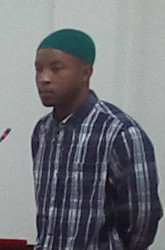Inmate Michael Lewis yesterday maintained that tear gas was thrown into the Capital Division of the Camp Street Prison on the day a fire raged through the area claiming 17 lives.
He was responding to assertions by counsel for the Guyana Prison Service and the Guyana Police Force that no tear gas was thrown.
Lewis was testifying at the Commission of Inquiry set up by President David Granger into the deaths on March 3rd, 2016. The hearings are being held at the Department of the Public Service, Waterloo Street.
Lewis also testified that the destruction to the wall separating the blocks in the Capital Division had been carried out on the first night of unrest and was intended to aid in communication between the prisoners.
Lewis had on Tuesday testified that a hole had been made in the wall separating Blocks A and B of the Capital Division after prison officials locked the door to Block A. After this was done, he said, prisoners Jermaine Otto and “Shaka” jumped through the hole into Capital B to warn the other prisoners not to go outside as they were beating inmates. Similar evidence was submitted by the inmates before him, who both testified that the hole was made after calls came from officials for the doors to be shut.

But under cross-examination by attorney Selwyn Pieters yesterday, Lewis, who was previously housed in Block A of the Capital Division, claimed that the hole was created entirely by the inmates in Block B. He later came to explain, when re-examined by Commission Counsel Excellence Dazzell, that the inmates punched the hole in the wall sometime between the evening of March 2, and the day of March 3. He had earlier said he was unsure of how the hole was formed, but said he assumed it was done using metal broken off from the beds of the prisoners. He said too, that prison officials had known of the existence of the hole since the night of March 2, and had done nothing about it.
When asked by Pieters whether the wall may have been broken to facilitate the passage of prohibited items such as cellphones, ice picks, knives and marijuana, Lewis said he had never seen such items in his two years in the prison. When pressed further about his claim that he had never seen cellphones in the prison, nor used one, Lewis replied that the only time he had seen cellphones was when senior officers went to conduct searches and had them on their person.
On the contrary, inmate, Dwain Lewis, who testified on March 10, said that possession of cellphones and marijuana in the division was a normal occurrence and stated that two margarine buckets of the items were taken from the dormitory after the search on the morning of March 2.
No tear smoke
Contrary to the reports of the three witnesses who have appeared so far, Pieters suggested that no tear smoke had been introduced to the dorm on the day of the fire. He further suggested that the burning the inmates had felt was in fact the result of the chemicals from the fire extinguisher combined with the chemicals in the mattresses which were lit by the inmates. These claims were denied by Lewis.
He suggested as well, that had tear gas actually been released into the room, the effects would have been felt at the Commission’s visit to the prison on Tuesday. Lewis maintained that tear gas had been thrown into the dorm.
His fellow inmate, Dwain Lewis, on the first day testified that six canisters of tear gas were thrown into the dorm from the outside of the building, likely through square holes in the wall which measure 5×5 inches.
In Michael Lewis’s testimony on Tuesday, he had claimed he saw two hands throwing two cans of tear smoke into the Capital A block through the hole the inmates had broken in the wall separating the two blocks. These cans, he said, were thrown into the room by an officer dressed in riot gear.
Credibility
Meanwhile, Pieters brought into question Lewis’ credibility, raising questions about whether he was in fact illiterate as he had earlier claimed.
At his first appearance, the prisoner had testified that he could not read and write well and that the statement he submitted to the commission, which was written by another inmate and was incomplete at the time it was admitted, had been rushed, and he had not had the chance to have the document read back to him. He had, however, attached his signature to said document.
Pieters’ claims were that Lewis, who is a Muslim, had been entrusted by prison officials in a leadership role, where he was tasked with conducting prayer sessions. His duties, he suggested, entailed gathering the prisoners and teaching them, which sometimes required that he write on a blackboard.
Lewis continuously denied these allegations, explaining that his role was that of an orderly, and his only duty was to collect his fellow Muslim inmates and take them to the place where they gathered for prayer. Lewis stated that any writing on the board and any teachings would have been conducted by his other “well-learned brothers.”
When asked if there are any documents at the prison with his signature, he said he could not recall, but explained that they would be required to sign their names in a book at the gathering of every prayer session.




